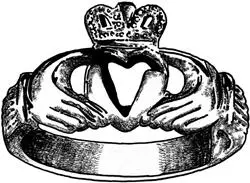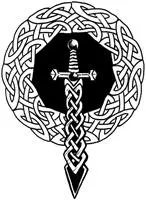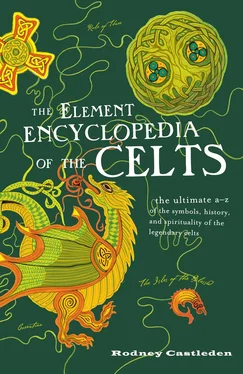1 ...7 8 9 11 12 13 ...32 This may seem an odd place for Arthur to be fighting a battle in that the threat from the Saxons was from the east. But the various traditions about the last battle have in common the idea that it was a fight amongst the British. Arthur was betrayed by a relative, perhaps a nephew, called Modred or Medraut. With that in mind, the final battle might have been fought well inside the frontiers of Britannia Prima, in Devon, Cornwall, or anywhere in Wales.
The North Wales location suggests that Arthur was making his way north into the kingdom of Gwyneddalong the major south–north Roman roadknown as Sarn Helen. The King of Gwynedd was Maelgwn, and his fortress was Castell Degannwy, perched on a rocky, twin-peaked hilltop overlooking the Conwy estuary. Like many other Dark Age strongholds, this was a refortified Iron Age fort. The site has yielded sixth-century pottery and there is a tradition that it was the seat of Maelgwn, though, like Arthur, Maelgwn had a less conspicuous refuge residence, at Aberffraw on the west coast of Anglesey. Degannwy was Maelgwn’s frontline fortress, and this was where Arthur was heading. The last battle took place in an atmosphere of distrust and civil war, and Arthur was probably hoping to deal with Maelgwn’s disloyalty.
Maelgwn had a reputation for ruthlessness. We know from the outright condemnation of him by Gildas that he murdered his own uncle in order to become King of Gwynedd; now he was envious of Arthur’s High Kingship and determined to get it for himself. Maelgwn was Arthur’s enemy; the king who was destabilizing the British confederation and who wanted him dead so that he could be dux bellorum himself.
Whether Arthur and his war-band rode into Gwynedd to quell an overt rebellion and open and anticipated hostility or were lured there by some guile of Maelgwn’s and fell unsuspecting into a trap at Ganllwyd cannot be determined from the existing evidence. Certainly the site, confined by steep valley sides and dense forests, is ideal for an ambush.
Two things are known for certain: Maelgwn did gain the High Kingship shortly after the Battle of Camlann and Arthur’s disappearance—in 546, according to one version—and gained it by deception. There is also the tradition that Arthur was in the end the victim of treachery at Camlann: perhaps the treachery was Maelgwn’s, not Modred’s. And just possibly Arthur was the murdered “uncle” mentioned by Gildas.
If Maelgwn was indeed responsible for the death of Arthur and for bringing the Arthurian peace to an end, Gildas’s extraordinary hatred and condemnation of Maelgwn’s many-sided wickedness becomes understandable. Arthur was behind the golden years of relative stability and justice between the Battles of Badon and Camlann, and those years came to an end with his final defeat. Gildas mentions specifically that Maelgwn removed and killed many tyrants (meaning kings, not necessarily tyrants in the modern sense), that Maelgwn was “last in my list but first in evil,” and that Maegwn “cruelly despatched the king your uncle.” Here, too, is the uncle-slaying regicide motif that would later be attributed, by Geoffrey of Monmouth, and possibly mistakenly, to Modred.


THE DISAPPEARANCE OF ARTHUR
What happened to Arthur after the Battle of Camlann is shrouded in mystery. One version of the story is that he was carried from the battlefield mortally wounded and either died elsewhere or simply disappeared. One explanation is that locally the truth of the matter was known—that Arthur had died on or near the battlefield—and this tradition was preserved and passed on through Welsh families, like the details about the few fellow warriors who survived the battle. Meanwhile, Arthur’s subjects in Cornwall had less detailed information about what had happened to the king. All they really knew was that he had not returned. In the days and weeks following the Battle of Camlann, all kinds of misinformation and rumor may have circulated.
Writing in the Middle Ages, Geoffrey of Monmouth was aware of the uncertainties. In his version of Arthur’s disappearance he describes him as “mortally wounded” on the battlefield, yet moved to Avalon“to have his wounds healed.” Some scholars have argued persuasively that Geoffrey was deliberately ambiguous about what had happened because he had on his desk two different versions of the king’s fate: one originating in Wales and giving Arthur as killed in battle; the other from Cornish or Breton sources and giving Arthur as surviving the battle and being transported elsewhere to recover or die.
This is persuasive and goes a long way toward explaining the post-Camlann confusion, but it may be that the contradictory stories carried a different clash of scenarios. It may have been known, to a privileged few in Wales, that Arthur had been wounded, rescued from the battlefield, and taken north to a place of safety; meanwhile, in Cornwall, the story was that Arthur was “missing presumed dead.”
Great play has been made of the absence of a grave for Arthur. The sixth or seventh-century poem Songs of the Graves gives the locations of many Dark Age heroes, for instance:
The grave of Owain ap Urien in a secluded part of the world,
Under the grass at Llan Morvad;
In Aberech, that of Rhydderch Hael. (Stanza 13)…
The wonder of the world, a grave for Arthur. (Stanza 44)
The missing grave became a major element in the mystique surrounding the vanished king. If Arthur was the great overking, chief of the kings of Britain and dux bellorum , we might expect to find an impressive monument of some kind raised over his grave, or at any rate for its location to have been remembered, but there is nothing. On the other hand, where is the grave of Aelle, the first Saxon bretwalda ? Where is Vortigern’s mausoleum? Even the whereabouts of the tombs of King Alfred and King Harold are uncertain. So perhaps we should not be surprised that we have no grave for Arthur.
There is a tradition that he was buried secretly. The Life of St. Illtud credits Illtud with being the priest who conducted the secret funeral. Probably only those who were actually present—perhaps only ten people altogether—ever knew where the king was buried, and as likely as not those ten took the secret with them to their own separate graves.
One question naturally arises: why should those close to Arthur have wished to bury him in secret? Obviously his death was disastrous to the British cause. If he had succeeded only recently in re-cementing the loyalty of the kings of southern and central Wales to a common cause, the news of his death could have precipitated immediate fragmentation, laying Wales open to attack from the east; alternatively, and equally dangerously, it could have exposed Powysand the southern kingdoms to attack from Gwynedd first, rendering them powerless to resist Saxon incursion from the east. The continuing expansion of Gwynedd a century or two later seems to show that this was an ever-present danger. If news of Arthur’s death had reached the Saxons, who had been held at bay by his power for 20 years, they would have pushed westward with confidence and ease; if it had spread widely among the Britons, they would have been demoralized and given in under the renewed Saxon onslaught. In every way and for every reason it was important to conceal the death of Arthur, and those close to him may have hoped to hide the catastrophic truth long enough for a successor to be found and for him to establish his position as overking before too many people realized what had happened.
Читать дальше














